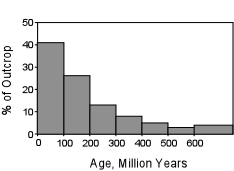
| Geology 212 | Petrology |
Prof. Stephen A. Nelson |
Occurrence, Mineralogy, Textures, and Structures of Sedimentary Rocks |
||
| Rivers, oceans, winds, and rain runoff all have the ability to carry the particles washed off of eroding rocks. Such material, called detritus, consists of fragments of rocks and minerals. When the energy of the transporting current is not strong enough to carry these particles, the particles drop out in the process of sedimentation. This type of sedimentary deposition is referred to as clastic sedimentation. Another type of sedimentary deposition occurs when material is dissolved in water, and chemically precipitates from the water. This type of sedimentation is referred to as chemical sedimentation. A third process can occur, wherein living organisms extract ions dissolved in water to make such things as shells and bones. This type of sedimentation is called biogenic sedimentation. Thus, there are three major types of sedimentary rocks: that can be grouped by the type of particle found in the rocks. |
|
| 95% of all sedimentary rocks consists of sandstones (made up of sand sized fragments), mudrocks (made up of silt and clay sized fragments), and carbonate rocks (made up of mostly calcite, aragonite, or dolomite). Of these, the mudrocks are most abundant, making up about 65% of all sedimentary rocks. Sandstones make up 20 to 25% of all sedimentary rocks, and carbonate rocks account for about 10 to 15% of all carbonate rocks. |
The Occurrence of Sedimentary Rocks Sedimentary rocks have an average thickness of about 1800 m on the continents. This thickness is quite variable, however, with some areas, like the Canadian Shield having no cover of sedimentary rocks, and other areas, like the Louisiana and Texas Gulf coasts, having more than 20,000 m of sedimentary rock cover. Still, about 66% of all continental areas have a cover of sedimentary rocks. |
| Because sediment gets buried, and if exposed gets eroded, older sedimentary rocks show less exposed outcrop area than younger sedimentary rocks. Over 40% of the exposed sedimentary rocks are younger than Cretaceous in age. |  |
Depositional Basins In order for sediment to be deposited, a low lying area, called a basin, is required. The largest of basins are the ocean basins, which currently cover about 70% of the Earth's surface. In the past, however, sea level has often changed, resulting in episodes where even the continents were covered by shallow seas, referred to as epiric or epicontinental seas. When sea level rises to invade the continents it is referred to as a transgression. Major transgressions occurred during the Cretaceous, and from the Early Cambrian through Mississippian (See your text for a more detailed discussion). It is for these reasons that most of the sedimentary rocks preserved in the geologic record are marine sediments. Basins result from plate tectonics, and even the large transgressions
appear to be related to tectonic factors, as increased spreading rates in the ocean basins
can result in changing the configuration of ocean basins that result in flooding of the
continents. For a classification of the various types of basins see your text. |
The Mineralogy of Sedimentary Rocks Because of their detrital nature, any mineral can occur in a sedimentary rock. Clay minerals, the dominant mineral produced by chemical weathering of rocks, is the most abundant mineral in mudrocks. Quartz, because it is stable under conditions present at the surface of the Earth, and because it is also a product of chemical weathering, is the most abundant mineral in sandstones and the second most abundant mineral in mudrocks. Feldspar is the most common mineral in igneous and metamorphic rocks. Although feldspar eventually breaks down to clay minerals and quartz, it is still the third most abundant mineral in sedimentary rocks. Carbonate minerals, either precipitated directly or by organisms, make up most biochemical and chemical sedimentary rocks, but carbonates are also common in mudrocks and sandstones. |
Mineral Composition Mudrocks %
Sandstones %
Clay minerals 60 5 Quartz 30 65 Feldspar 4 10 - 15 Carbonate minerals 3 <1 Organic matter, hematite, & others <3 <1
Minerals found in sedimentary rocks can be divided into 2 classes:
|
Any mineral can be an allogenic mineral, but some are more stable under the conditions
present at the Earth's surface than are others. Conditions that are present at the
Earth's surface and differ from those where most minerals form are:
Because these conditions differ from those under which most rocks form, allogenic minerals can be classified based on their stability under near surface conditions. Such a classification, with minerals listed in order of increasing stability is as follows: |
Stability Under Conditions Present at Surface Mineral Unstable Olivines* Pyroxenes* Ca-rich Plagiocalse* Hornblende* Andesine - Oligoclase* Less Unstable Sphene Epidote Andalusite Staurolite Kyanite Sillimanite Magnetite Garnet Very Stable Muscovite* Albite* Orthoclase/Microcline* Clay Minerals Quartz* Tourmaline Zircon
| In this list, the igneous minerals have an asterisk (*). Note that the order in which they occur is in the same order that occur in Bowen's reaction series. Igneous minerals that crystallize at the highest temperatures are most out of equilibrium at the Earth's surface, and are therefore the most unstable. |
| Minerals that are very stable at the Earth's surface are minerals that either form as
a result of chemical weathering, or crystallize at the lowest temperatures. Authigenic minerals can also be allogenic minerals, but some are formed during diagenesis but not very stable in the transportation cycle either because they dissolve readily in water or because they are easily abraded during transportation. Thus we can divide authigenic minerals into those that are stable during diagenesis and transportation, and those that are unstable during transportation. |
Unstable Authigenic Minerals
Gypsum Carbonate Minerals Apatite Gluaconite Pyrite Zeolites Stable Authigenic Minerals Chlorite Albite Orthoclase Muscovite Quartz Clay Minerals
The longer a mineral is in the weathering and transportation cycles of sedimentary
rock forming processes, the more likely it is to break down to a more stable mineral or
disappear altogether. Thus, we can classify sediments on the basis to which they
have achieved mineralogical maturity.
|
Textures of Sedimentary Rocks Since most sedimentary rocks are derived by processes of weathering, transportation, deposition, and diagenesis, the textures we find in sediment and sedimentary rocks are dependent on process that occur during each stage. These include:
|
|
| Grain Size Clastic sediments and sedimentary rocks are classified on the basis of the predominant grain size of clasts in the rock as per the table below. |
Name of Particle |
Size Range |
f Scale |
Loose Sediment |
Consolidated Rock |
| Boulder | >256 mm | <-8 | Gravel
|
Conglomerate or Breccia (depends on rounding) |
| Cobble | 64 - 256 mm | -6 to -8 | ||
| Pebble | 4 - 64 mm | -2 to -6 | ||
| Granule | 2 - 4 mm | -1 to -2 | ||
| Very Coarse Sand | 1 - 2 mm | 0 to -1 | Sand | Sandstone |
| Coarse Sand | 0.5 - 1 mm | 1 to 0 | ||
| Medium Sand | 0.25 - 0.5 mm | 2 to 1 | ||
| Fine Sand | 0.125 - 0.25 mm | 3 to 2 | ||
| Very Fine Sand | 0.0625 - 0.125 mm | 4 to 3 | ||
| Coarse Silt | 0.031 - 0.625 mm | 5 to 4 | Silt
|
Siltstone |
| Medium Silt | 0.016 - 0.031 mm | 6 to 5 | ||
| Fine Silt | 0.008 - 0.016 mm | 7 to 6 | ||
| Very Fine Silt | 0.004 - 0.008 mm | 8 to 7 | ||
| Clay | <0.004 mm | >8 | Clay | Claystone, Mudstone, Shale |
| Note how the particle sizes small than pebble size are defined. The lower size limit of granules is 1/2 the lower size limit of pebbles, the lower size limit of coarse sand is 1/2 the lower size limit of granules, etc. For this reason, grain size is often given in units called f (phi) units, where f is defined as follows: |
This is convenient for grain size analyses of sediment, or rocks if they can be disaggregated, because sieves can be constructed where the opening of each sieve is 1/2 the size of the sieve above. Sediment put through such a set of sieves, will be trapped in different sieves, and sorted by grain size. The amount of grains in each sieve can then be weighed to give a quantitative measure of the size distribution of sediment. One precaution- note how the large grain sizes have negative f units. |
| Sorting - Sorting refers to the uniformity of grain size in a sediment or sedimentary rock. Particles become sorted on the basis of density because of the energy of the transporting medium. High energy (high velocity) currents can carry larger fragments. |
| As the energy or velocity decreases, heavier particles are deposited and lighter fragments continue to be transported. This results in sorting due to density. If the particles have the same density, such as all grains of quartz, then the heavier particles will also be larger, so the sorting will take place on the basis of size. We can classify this size sorting on a relative basis: well-sorted to poorly-sorted. | 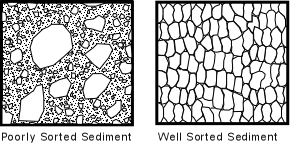 |
| In a more quantitative sense, sediment can be sieved to determine the distribution of grain size, as noted above. By weighing the amount of sediment or disaggregated sedimentary rock that occurs in each sieve then re-summing to 100%, a histogram can be constructed to show the size distribution of the sediment. To simplify matters, we can also construct a frequency curve by drawing a smooth curve through the midpoints of the histogram. | 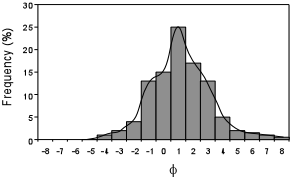 |
| In a quantitative sense, sorting is a measure of the standard deviation from the mean grain size. Thus, on a histogram or frequency curve, a narrow peak has a low standard deviation and would represent well sorted material. A broad, spread-out frequency curve would indicate a poorly sorted sediment. |
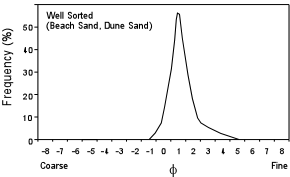 |
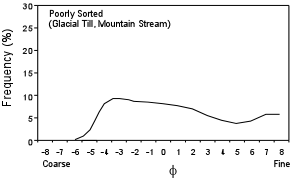 |
| Beach sands and dune sands tend to be well-sorted because the energy of the waves or
wind is usually rather constant. The coarser grained sediment is not carried in
because the wave or wind velocity is too low to carry such large fragments, and the finer
grained sediment is kept in suspension by the waves or wind. Mountain streams, because they have many turbulent eddies where the velocity of the stream changes suddenly usually show poorly-sorted sediment on the bottom of the stream channel. Similarly, glacial till, because it is deposited in place as glacial ice melts, and is not transported by water, tends to show poor sorting.
|
| Rounding - During the transportation process, grains may be reduced in size due to abrasion. Random abrasion results in the eventual rounding off of the sharp corners and edges of grains. Thus, the degree of rounding of grains gives us clues to the amount of time a sediment has been in the transportation cycle. Rounding is classified on relative terms as well. Note that rounding is not the same a sphericity. Sphericity is controlled by the original shape of the grain. | 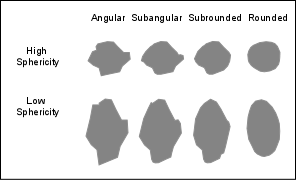 |
| Porosity- Porosity is the percentage of
the volume of the rock that is open space (pore space). This determines the amount of
water or other fluids, like petroleum, that a rock can contain. In sediments or
sedimentary rocks the porosity depends on grain size, the shapes of the grains, the degree
of sorting, and the degree of cementation. |
|
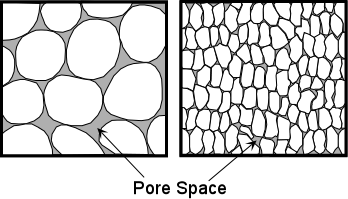 |
|
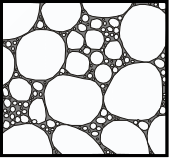 |
|
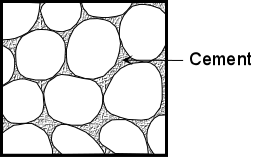 |
| Packing of Grains- Packing refers to the
arrangement of clastic grains entirely apart from any authigenic cement that may have
later crystallized between them. If the clastic grains touch each other throughout, the
rock is said to be grain supported. If the rock is poorly sorted and the grains are
separated by a mud or silt matrix, the rock is said to be matrix supported. Matrix- If the rock is poorly or moderately sorted, the percentage of matrix and texture of the matrix should also be described. Induration- Induration refers to the hardness of the rock or how easily it breaks apart. Well indurated rocks are difficult to break with a hammer. Moderately indurated rocks can be easily broken with a rock hammer. Poorly indurated or friable rocks break apart easily in your hand. The term non-indurated would describe a sediment that has not undergone any cementation. |
| Textural Maturity The longer sediment is involved in the transportation cycle, the more time it has to become well-sorted. Similarly, the longer the sediment is transported, the more time is available for grains to lose their rough edges and corners by abrasion. Thus, we consider a texturally mature sediment to be sediment that is well-sorted and well-rounded. Note that sediment tends to become both texturally and mineralogically mature the longer it is in the transportation cycle. |
| Descriptions of Texture A complete description of the texture of a sedimentary rock should include statements about each of the factors discussed above. To summarize, these are:
Structures of Sedimentary Rocks The process of deposition usually imparts variations in layering, bedforms, or other structures that give clues to environment in which deposition occurs. Such things as water depth, current velocity, and current direction can be sometimes be determined from sedimentary structures. Thus, it is important to recognize various sedimentary structures so that we can interpret the clues that they offer to these conditions. |
Also, because sedimentary rocks can be deformed by folding and faulting long after the deposition process has ended, it is important to be able to determine which was up in the rock when it was originally deposited, especially if one is going to use the rocks to determine the sequence of events that occurred or interpret the geologic history of an area. Features that tell us which way was up are often referred to as top and bottom indicators. Here we explore some the structures that occur in sediments and sedimentary rocks and provide information on how to interpret these structures. Stratification and Bedding Layering is usually described on the basis of layer thickness as per the table below. Other distinctive types of layering are described below. |
Layer Thickness Names > 300 cm Massive 100-300 cm Very thickly bedded 30 - 100 cm Thickly bedded 10 - 30 cm Mediumly bedded 3 - 10 cm Thinly bedded 1 - 3 cm Very thinly bedded 0.3 - 1 cm Thickly laminated <0.3 cm Thinly laminated
|
This is sometimes caused by seasonal changes in deposition (Varves). i.e. lake deposits wherein coarse sediment is deposited in summer months and fine sediment is deposited in the winter when the surface of the lake is frozen. |
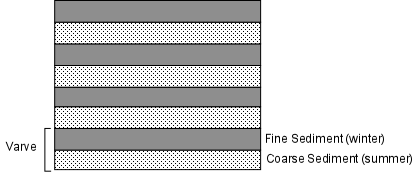 |
|
 |
|
 |
|
|
 |
| Surface Features |
|
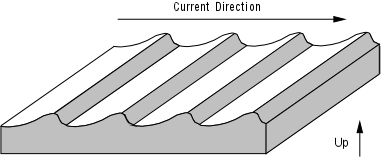 |
Symmetrical ripple marks occur in environments where there is a steady back and forth movement of the water. Such ripple marks can still be used as top and bottom indicators. |
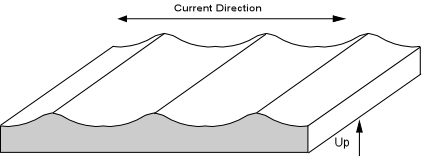 |
|
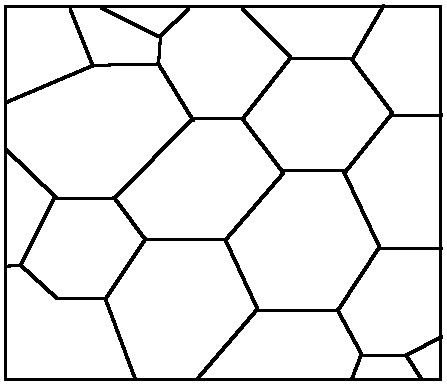 |
|
|
|
|
 |
Sedimentary Facies A sedimentary facies is a group of characteristics that
reflect a sedimentary environment different from those elsewhere in the same deposit.
Thus, facies may change vertically through a sequence as a result of changing environment
through time. Also, facies may change laterally through a deposit as a result of changing
environments with distance at the same time. The structures and textures found in sedimentary rocks give clues to the environment of deposition, as discussed above, and thus allow geologists to assign parts of a deposit to a particular sedimentary facies. Individual facies are generally described in terms of the environment is which deposition occurred. The following are facies or environments are among those possible: |
I. Terrigenous or Non-marine Facies |
II. Near Shore Facies |
|
|
III. Shallow Marine (depths < about 200 m) |
IV. Deep Marine Facies |
|
|
| Each of these could be subdivided further. A description of each of these facies is beyond the scope of the present course and will be covered in more detail in your future course in sedimentology and stratigraphy. |
| Return to Geology 212 Home Page |